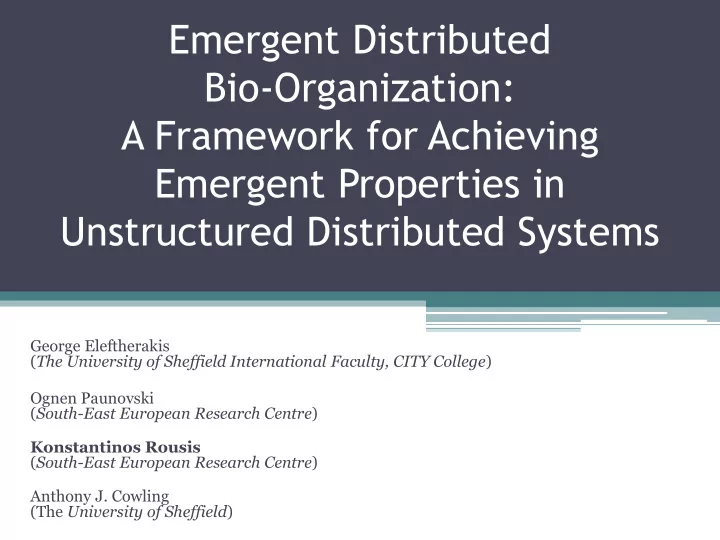

Emergent Distributed Bio-Organization: A Framework for Achieving Emergent Properties in Unstructured Distributed Systems George Eleftherakis ( The University of Sheffield International Faculty, CITY College ) Ognen Paunovski ( South-East European Research Centre ) Konstantinos Rousis ( South-East European Research Centre ) Anthony J. Cowling (The University of Sheffield )
Outline • Complexity and Traditional Engineering • A Framework for Harnessing Emergent Properties • EDBO: Applying the Framework in Practice ▫ Hypothesis and implanted behaviour ▫ Expected emergent behaviour ▫ Preliminary results • Discussion & Next Steps
3 The Ever Increasing Complexity… • Hundreds of billions of CPUs already in products ▫ PCs represent less than 1% of those ( Ganssle Group) • Self-driving cars, unmanned autonomous aircrafts, autonomous spaceship swarms… • Healthcare , e-voting , transportation, military • And a 100$ phone nowadays has twice the computational power of last decade’s PCs
And the Ever Increasing Connectivity 4 • More than 2B Internet users • Cisco predicts the “Internet Boom”: more than 15B devices on Internet by 2015 • Mobile Internet, Internet of things , PANs …
Can Traditional Engineering 5 Cope with That? • Need for (re) configuration, deployment, management, maintenance… • And resilience should the environment or business needs change • Will traditional engineering techniques be able to cope with such unprecedented levels of complexity? ▫ Will we have the necessary human resources and the required skills to tackle such complexity?
6 Tackling the Complexity Implicitly • Emergence in natural systems is responsible for many beneficial properties: ▫ Adaptability, self-healing, self-organization, self-* • Artificial systems could greatly benefit (or suffer) from emergent properties • Controlling emergence could provide an implicit way to engineer complex systems and behaviours ▫ By focusing solely on the microscopic level
An Experimental Framework for 7 Harnessing Emergence in ADS
The Emergent Distributed Bio- Organization Paradigm (EDBO) • A generic distributed systems paradigm ▫ Not a specific instantiation, could be used to model P2P file sharing, Web Services, etc. • Nodes are referred to as BioBots • Each BioBot acts as service provider & consumer • Services are located through a distributed query forwarding mechanism • BioBots are situated in the BioSpace
EDBO – Component Overview
Key Characteristics of EDBO • Bio-inspired properties and functions • Each BioBot possesses 2 energy levels ▫ Discovery Energy ▫ Service Energy (per service instance ) • Energy is fluctuating as BioBots are being rewarded or expend different amounts of energy • BioBots with high energy are able to perform special (bio-inspired) functions • BioBots without energy are removed from the system (node death)
Different Energy Gain and Loss Scenarios
Expected Emergent Properties & Preliminary Results • Network Scalability – adapt to very dynamic service demand peaks • Robustness and Availability – overall connectivity maintained to satisfactory levels • Super-node formations – although initially the network was completely unstructured
13 Next Steps • Separate case study from simulation platform • Precisely document the case study • Allow results to be reproducible • Cross-validate simulation results with these from a well-accepted, separate platform
Thank you for your time George Eleftherakis eleftherakis@city.academic.gr Konstantinos Rousis konrousis@seerc.org
Recommend
More recommend